Lake Monroe, located approximately 10 miles southeast of Bloomington, Indiana, is a massive reservoir spanning 10,750 acres, making it the largest man-made body of water in the state. It stretches across Monroe and Brown counties, encompassing a total area of 23,952 acres, including the lake itself. As a prominent feature of the Indiana State Parks system, Lake Monroe is renowned for its exceptional bass fishing opportunities. Whether engaging in open-water activities or navigating no-wake zones, the lake offers ample space for various water-based pursuits. With a maximum depth of 54 feet and an average depth of 17 feet, Lake Monroe boasts an impressive shoreline, extending for 103 miles. Outdoor enthusiasts are lured by an array of recreational activities, ranging from boating, fishing, and swimming to camping and hiking, making it a destination of choice.
Lake Monroe is home to a plethora of wild animals. From elegant herons, egrets, ducks, and geese, to deer, alligators, and turtles, you’ll encounter a diverse array of natural wonders. The lake is also teeming with a variety of fish species. Here is a list of different fish species that can be found living in Monroe Lake, Indiana:
- Black crappie
- Bluegill
- Brown bullhead catfish
- Channel catfish
- Common carp
- Flathead catfish
- Gizzard shad
- Hybrid striped bass
- Largemouth bass
- Northern pike
- Pumpkinseed
- Rainbow trout
- Rock bass
- Smallmouth bass
- Striped bass
- White crappie
- Yellow perch
Fish Living In Lake Monroe
Monroe Lake reveals an abundant tapestry of fish species that inhabit its depths. From the majestic largemouth bass to the elusive bluegill, this diverse ecosystem has a rich variety of aquatic life that entices anglers and nature enthusiasts alike. Now, let’s explore the waters and uncover the hidden treasures of this captivating lake teeming with life!
1. Black Crappie (Pomoxis nigromaculatus)
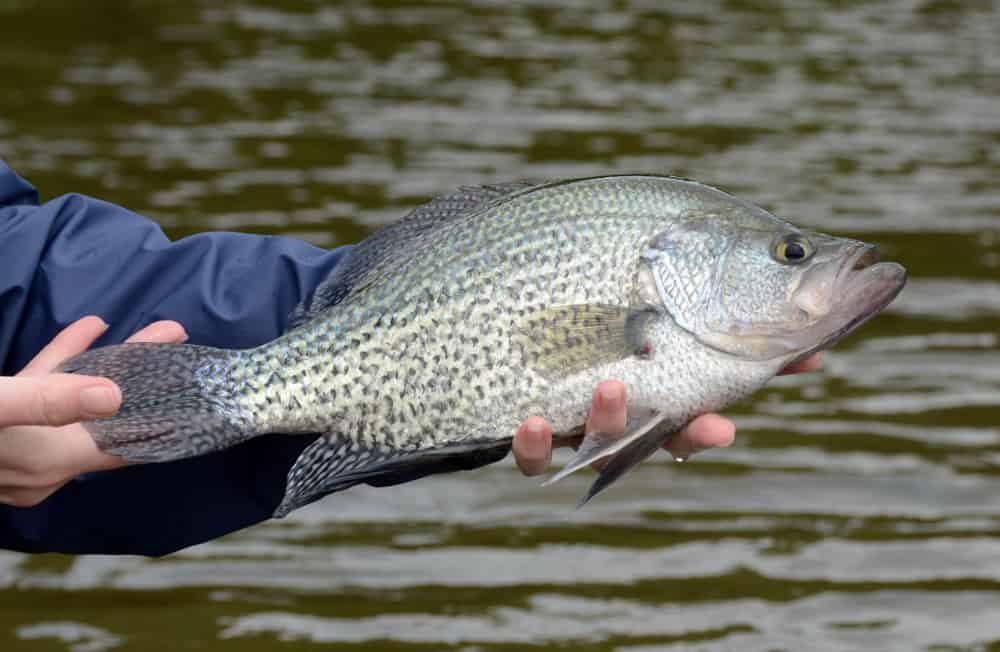
The delectable flavor of black crappie makes them highly sought after by many.
©M Huston/Shutterstock.com
Black crappie, a freshwater fish native to North America, belong to the sunfish family (Centrarchidae) and share a close kinship with white crappie. Typically between 10 to 12 inches, they can sometimes reach lengths of up to 16 inches. With a dark, blackish-green body adorned with irregular black spots, and dark fins with yellow or orange margins, black crappie thrive in various habitats including lakes, rivers, and ponds. They prefer shallow water teeming with lush vegetation where they capitalize on their ambush predator strategy, feasting on small fish, insects, and crayfish. Monroe Lake is a renowned hotspot for targeting black crappie, boasting a robust population and excellent fishing opportunities. For maximum success, the optimal seasons for black crappie fishing at Monroe Lake are during spring and fall, as the fish tend to venture deeper into the water during the summer months.
2. Bluegill (Lepomis macrochirus)
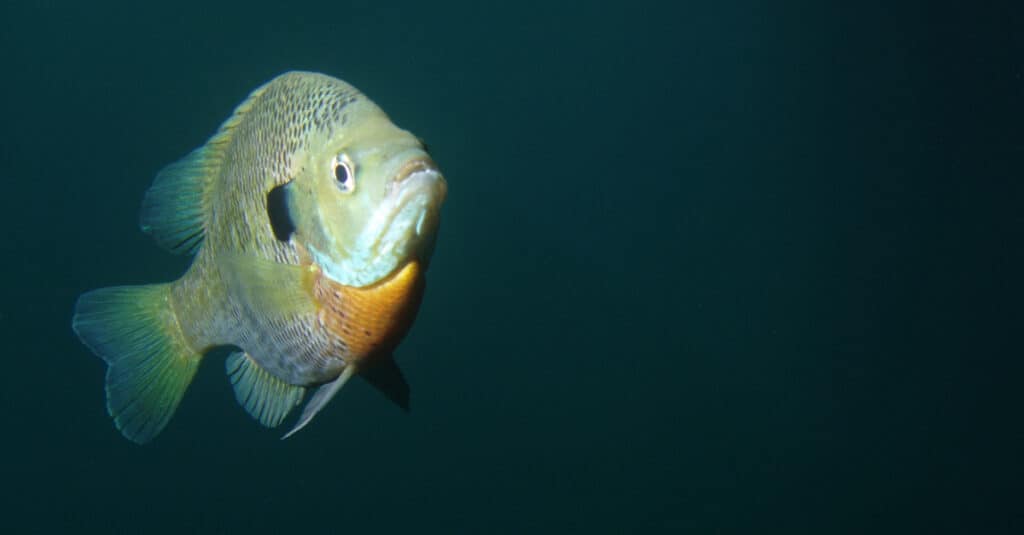
The bluegill is ecologically important as a native North American freshwater fish.
©iStock.com/Gant77
Bluegill is a significant freshwater fish species found in North America. They reach sexual maturity around one year of age and have a spawning season that aligns with the arrival of spring when water temperatures range from 60 to 65 degrees Fahrenheit. Bluegill can live up to ten years and grow to be 6 to 12 inches long. With a blueish-green body adorned with black spots, bluegill is typically found in shallow waters with abundant vegetation in lakes, rivers, and ponds. They are omnivores, feeding on insects, crustaceans, and small fish. Monroe Lake is a popular place for bluegill fishing, particularly during the spring and fall seasons. In summer, bluegill tends to move deeper into the water.
3. Brown Bullhead Catfish (Ameiurus nebulosus)
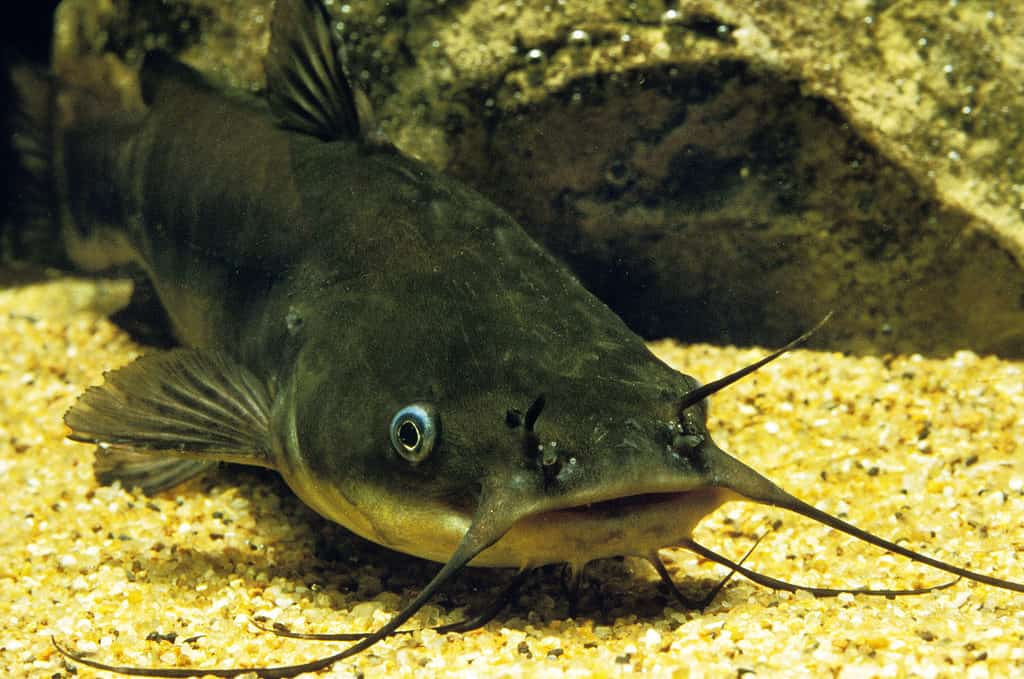
The brown bullhead, a type of bullhead catfish, has distinct markings.
©Slowmotiongli/Shutterstock.com
The brown bullhead is a freshwater catfish found in North America, belonging to the Ictaluridae family. Growing up to 24 inches long, they have a brown or olive body with dark blotches. They inhabit lakes, rivers, and ponds with muddy bottoms, feeding on small fish, crayfish, and insects. They are nocturnal predators and are popular among anglers at Monroe Lake. Brown bullheads, also known as mudcats or horned pout, reach sexual maturity at around 2 years and have a lifespan of up to 20 years. The best time to fish for brown bullheads in Monroe Lake is at night. During the day, the fish tend to hide in the mud.
4. Channel Catfish (Ictalurus punctatus)

Channel catfish, a prized game fish, thrive in the abundant freshwater lakes and rivers across North America.
©Aleron Val/Shutterstock.com
The most common type of catfish you will find in Indiana is the channel catfish. Anglers love these creatures for their mouthwatering flavor and exhilarating fights. Hailing from Indiana and calling Lake Monroe their home, channel catfish can be found in the shallows near vibrant aquatic vegetation, submerged logs, and other hidden nooks. With their penchant for scavenging, they feast on a diverse menu of insects, crayfish, small fish, and worms. While they may not grow too large, around 20 inches, their sheer numbers make them an absolute delight for fishing enthusiasts to reel in and savor. The best times to catch channel catfish in Monroe Lake are in the spring and fall.
5. Common Carp (Cyprinus carpio)

Wild common carp are remarkably tolerant of diverse water conditions, including low oxygen levels and high temperatures.
©Vladimir Wrangel/Shutterstock.com
The common carp is a large bottom-feeding fish indigenous to Europe and Asia. It was introduced to North America during the 1800s and has since established itself in numerous freshwater lakes and rivers. While not classified as a game fish, common carp are sought after by anglers who relish the thrill of catching sizable specimens. They can reach weights of up to 40 pounds, but most common carp captured in Lake Monroe are under 10 pounds. These versatile creatures are omnivorous and consume algae, plants, insects, and small fish. They employ their gill rakers to filter feed and extract food particles from the water. Common carp exhibit a nonchalant habitat preference, adapting to various environments such as lakes, rivers, ponds, and even ditches.
6. Flathead Catfish (Pylodictis olivaris)

The flathead catfish can often be found dwelling near the riverbed of the mighty Mississippi.
©iStock.com/stammphoto
Flathead catfish, magnificent and voracious, inhabit numerous freshwater bodies across North America, including Indiana’s Lake Monroe. They reign supreme, being the largest among Indiana’s three main catfish species, often reaching a staggering weight of 100 pounds or more! With elongated, sleek bodies and unmistakable flat heads adorned with a formidable maw brimming with sharp teeth, flathead catfish are cunning ambush predators, patiently lying in wait before launching their decisive strikes. Thriving in deep, sluggish waters graced with a muddy bottom, these nocturnal creatures come alive under the moonlight, showcasing their unparalleled hunting prowess. Their eclectic diet includes fish, frogs, crayfish, and even turtles, making them apex predators of their domain.
7. Gizzard Shad (Dorosoma cepedianum)

During spring and summer, female gizzard shad lay up to 100,000 eggs.
©mujijoa79/Shutterstock.com
Gizzard shad, native to North America, are small, silvery fish that play a vital role in the ecosystem. They serve as a crucial food for larger fish like bass, walleye, and catfish. Found in lakes, rivers, and reservoirs, gizzard shad dominate Lake Monroe as one of the most abundant species. They are an important part of the diet for many fish, including largemouth bass, smallmouth bass, walleye, and hybrid striped bass. Gizzard shad is also a vital food source for birds and other wildlife, as filter feeders consume plankton. They have a three-year lifespan, growing up to 18 inches. Anglers often use gizzard shad as bait when fishing for bass or other game fish in Lake Monroe. Gizzard shad has a remarkable impact on the ecosystem as a whole.
8. Hybrid Striped Bass (Morone saxatilis x Morone chrysops)
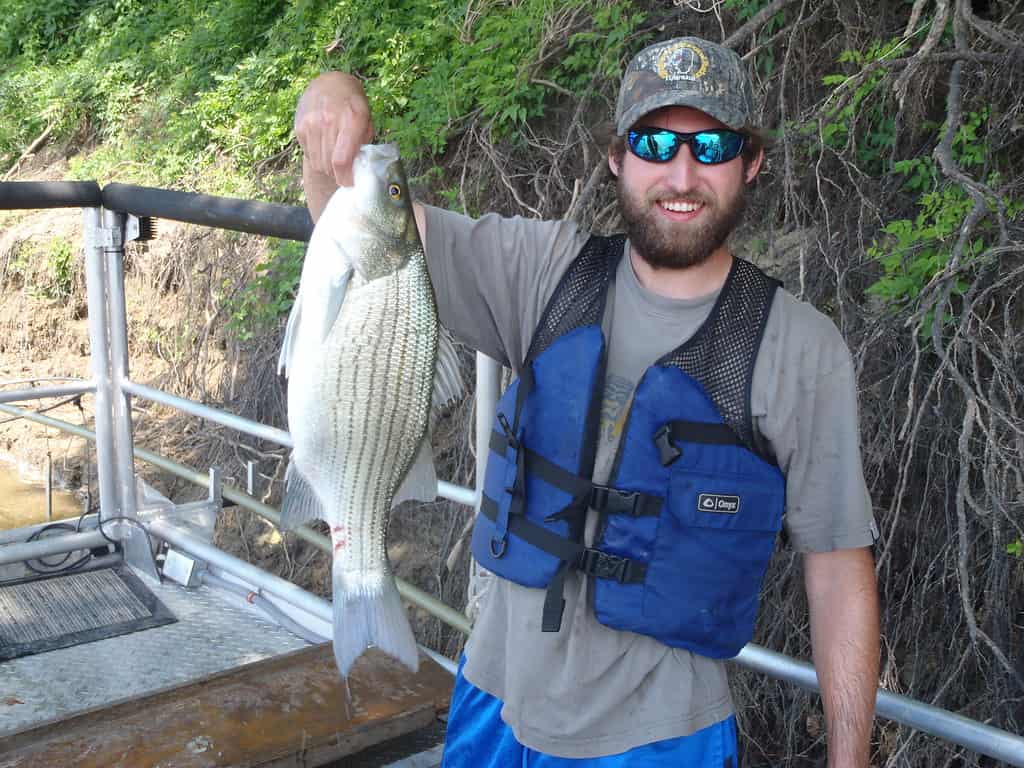
Hybrid striped bass
©USFWSmidwest / Public domain – License
A crossbreed of striped bass and white bass, hybrid striped bass exhibits unique characteristics. While they demonstrate greater tolerance to warm water and accelerated growth compared to pure striped bass. Notably more aggressive, these hybrids exhibit a higher inclination to take the bait. Lake Monroe in Indiana is home to both hybrid striped bass and white bass, with the Department of Natural Resources restocking fingerlings of both species annually. Within 2-3 years, these fish typically attain a catchable size of 14 inches. For optimal angling opportunities, the prime time to fish for hybrid striped bass in Lake Monroe extends from spring to fall. While these versatile fish can be found in various habitats, they are commonly sighted in the main lake, near river and stream mouths, and within shallow areas.
9. Largemouth Bass (Micropterus salmoides)
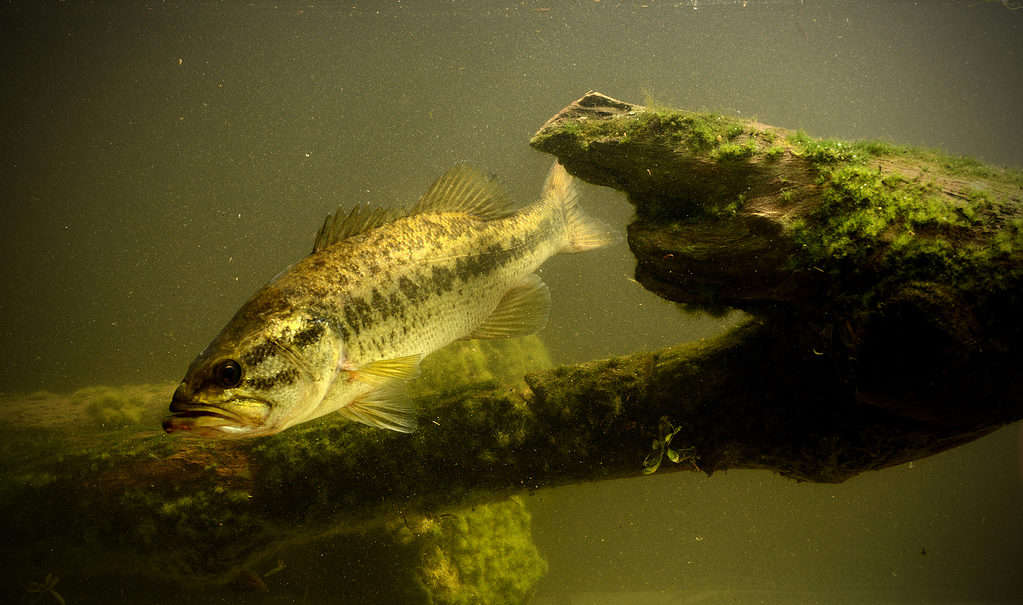
This voracious predator devours anything that can fit into its mouth, demonstrating its insatiable appetite.
©iStock.com/FtLaudGirl
Largemouth bass, a sought-after game fish, inhabits numerous freshwater lakes and rivers throughout North America. Renowned for their aggressive nature and impressive size, some specimens can exceed 20 pounds. Native to Indiana, these bass thrive in the waters of Lake Monroe, particularly in shallow areas with abundant vegetation, rocks, and submerged structures. Utilizing ambush tactics, they patiently await their prey before launching an attack. Known for their indiscriminate palate, largemouth bass consume a diverse diet consisting of insects, crayfish, small fish, and frogs.
10. Northern Pike (Esox lucius)
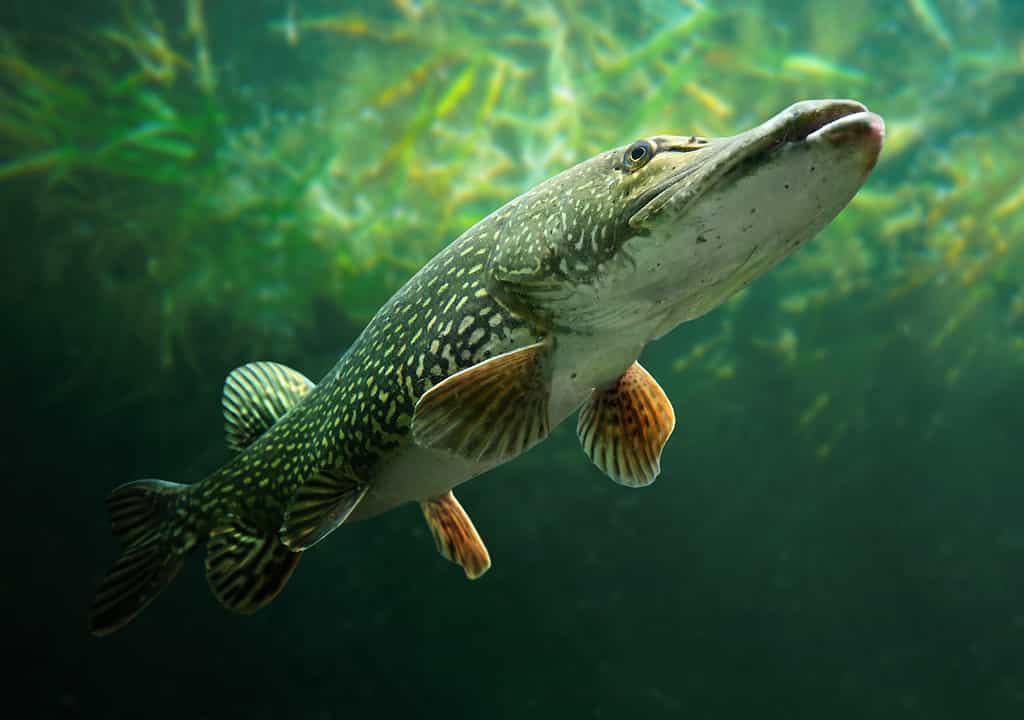
Notably, Northern pike have the potential to achieve impressive sizes, making them a fascinating species to encounter.
©iStock.com/abadonian
The Northern pike is a formidable freshwater fish species that thrives in lakes and rivers across North America. Revered by anglers for its aggressive nature and vigorous fights, the Northern pike is a coveted game fish. The Northern pike is also a prevalent species in Lake Monroe, thriving in the heart of the region where it calls its habitat home. While predominantly inhabiting deeper waters, these fish also venture into shallower areas during the spring spawning season. Employing ambush tactics, they are carnivorous hunters and patiently lie in wait for their prey before striking. Their diet comprises an assortment of fish, encompassing smaller pike, bass, sunfish, and panfish. In addition, they voraciously devour frogs, crayfish, and other small creatures.
11. Pumpkinseed Sunfish (Lepomis gibbosus)
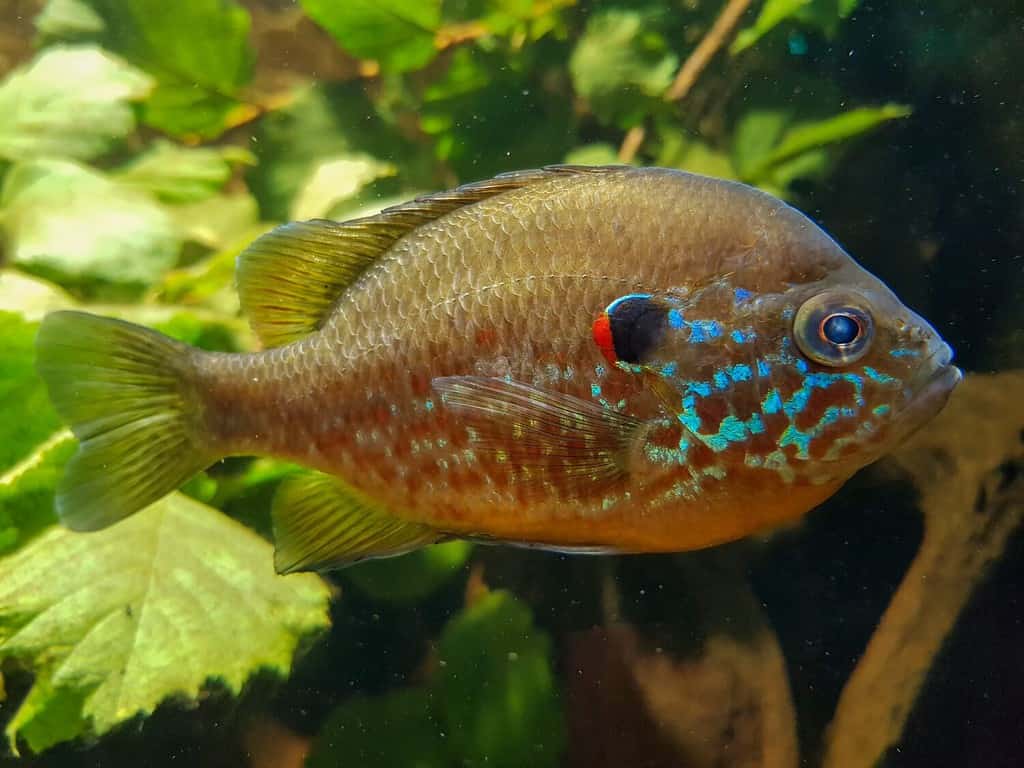
Measuring only around 6 inches in length, pumpkinseeds may be small but boast impressive numbers when fished, adding an element of excitement to any angler’s pursuit.
©Fabian Junge/Shutterstock.com
The pumpkinseed sunfish is a vibrant and petite fish commonly found in North American freshwater lakes and ponds. Belonging to the sunfish family (Centrarchidae), which also includes bluegill, redear sunfish, and largemouth bass, pumpkinseeds thrive in their native habitat of Indiana, particularly in Lake Monroe. These delightful creatures prefer the shallows, often gravitating toward weedy areas and the lake’s edges. With an omnivorous appetite, they savor a diverse menu consisting of insects, small fish, and aquatic plants.
12. Rainbow Trout (Oncorhynchus mykiss)
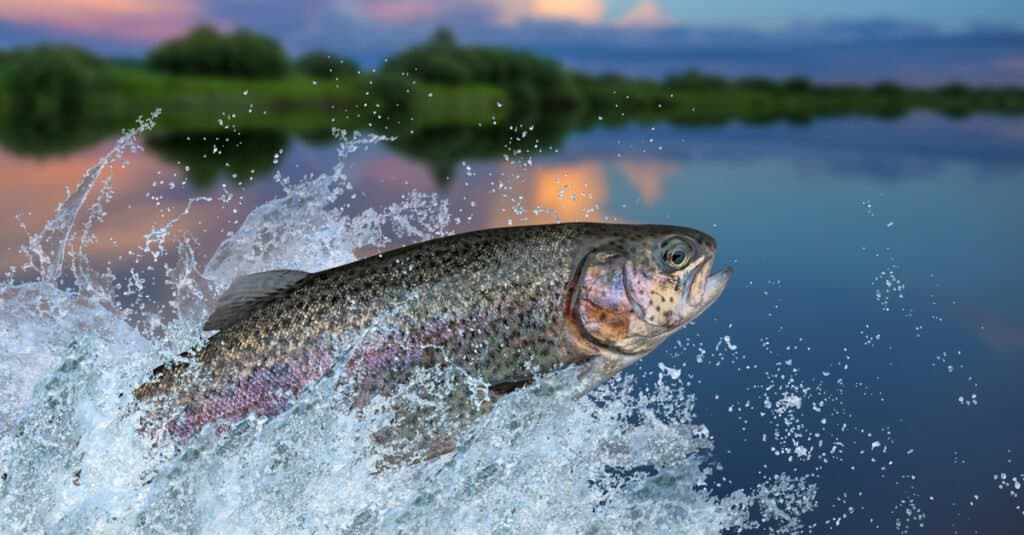
Rainbow trout are commonly found throughout the United States.
©FedBul/Shutterstock.com
The rainbow trout, native to the Pacific coast of North America, has made its way to different parts of the world, including Indiana. These trout typically measure 12 to 18 inches long but can reach up to 30 inches. Sporting a silvery body with pink or red streaks and green or blue-green backs, their orange or red fins add a striking touch. Found in lakes, rivers, and streams, rainbow trout thrive in cold, clear waters with a rocky bottom. In terms of diet, they are omnivorous, dining on insects, fish, and worms. Anadromous by nature, rainbow trout begin life in freshwater and migrate to the ocean to mature. Their presence in freshwater ecosystems aids in the regulation of insect and small fish populations. Throughout Indiana, lakes and streams are regularly stocked with rainbow trout, providing excellent fishing opportunities, particularly in the cooler spring and fall months.
13. Rock Bass (Ambloplites rupestris)
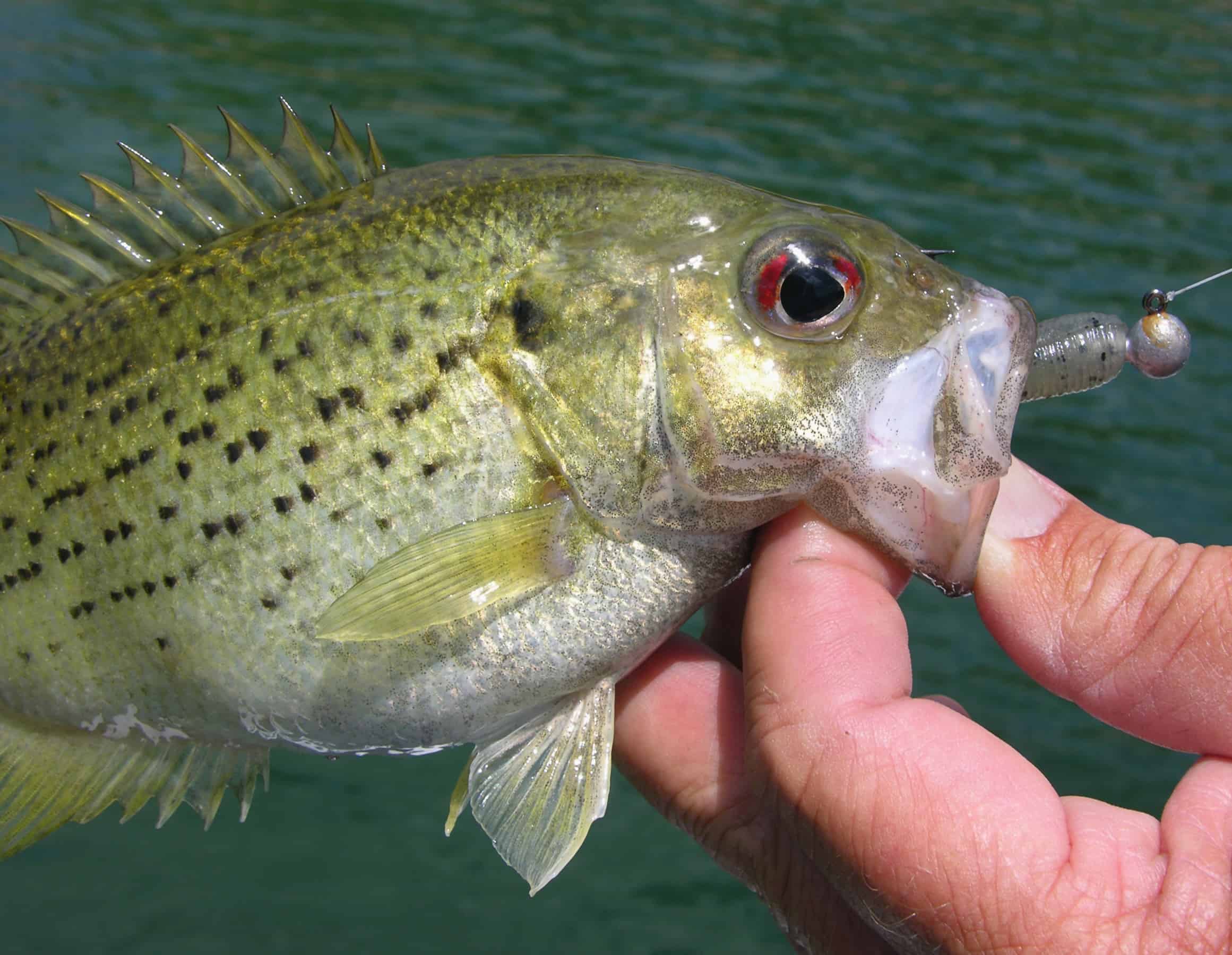
Lying in wait for unsuspecting prey, rock bass exhibit ambush predator behavior before striking.
©Steve Brigman/Shutterstock.com
Rock bass, also known as redeye bass, are small but spirited fish that inhabit numerous freshwater lakes and streams across North America. These popular game fish are renowned for their fierce fighting abilities and delectable flavor. Native to Indiana, rock bass thrive in the depths of Lake Monroe, preferring the shallows near rocks, logs, and other submerged structures. Despite their modest size, reaching only about 10 inches in length, they can be caught in abundance. In 1994, Lake Monroe yielded the Indiana state record rock bass, weighing an impressive 2.2 pounds. With a size limit of 10 inches, anglers are allowed to harvest only one bass exceeding 24 inches.
14. Smallmouth Bass (Micropterus dolomieu)
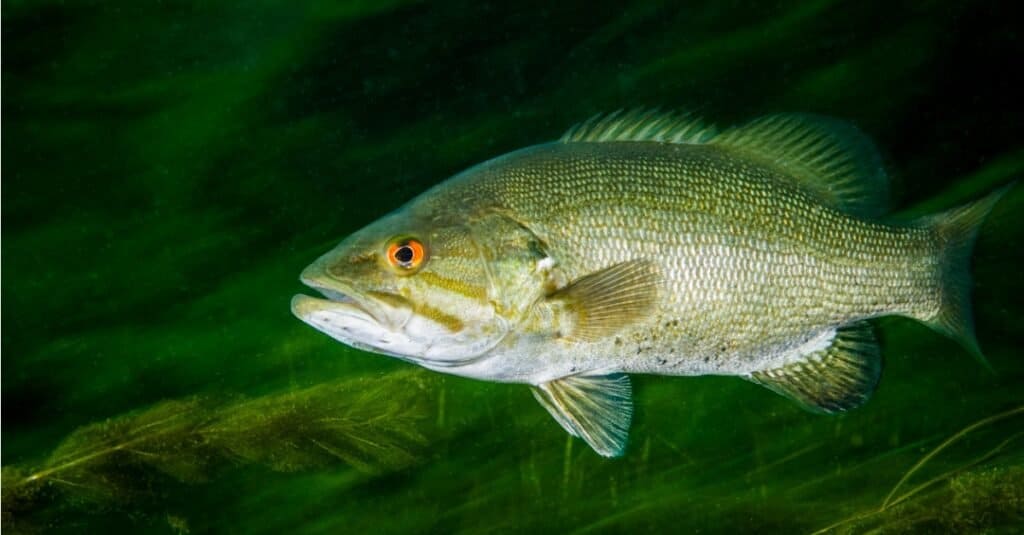
Bass are carnivores with a diverse diet consisting of insects, fish, and other small creatures.
©iStock.com/RLSPHOTO
Smallmouth bass, renowned for their aggressive feeding habits and acrobatic jumps, are a sought-after game fish in North America. These elusive creatures pose a captivating challenge to anglers, making the catch all the more fulfilling. When it comes to catching smallmouth bass, Lake Monroe stands as an exceptional fishing destination. This pristine lake has a robust population of smallmouth bass, thanks to its clear waters and rocky bottom creating an ideal habitat. Tucked within this picturesque body of water, smallmouth bass can be found in various spots, often congregating around points, drop-offs, and other underwater structures. During transitional periods, the moderate water temperatures invigorate the smallmouth bass, fueling their activity levels.
15. Striped Bass (Morone saxatilis)
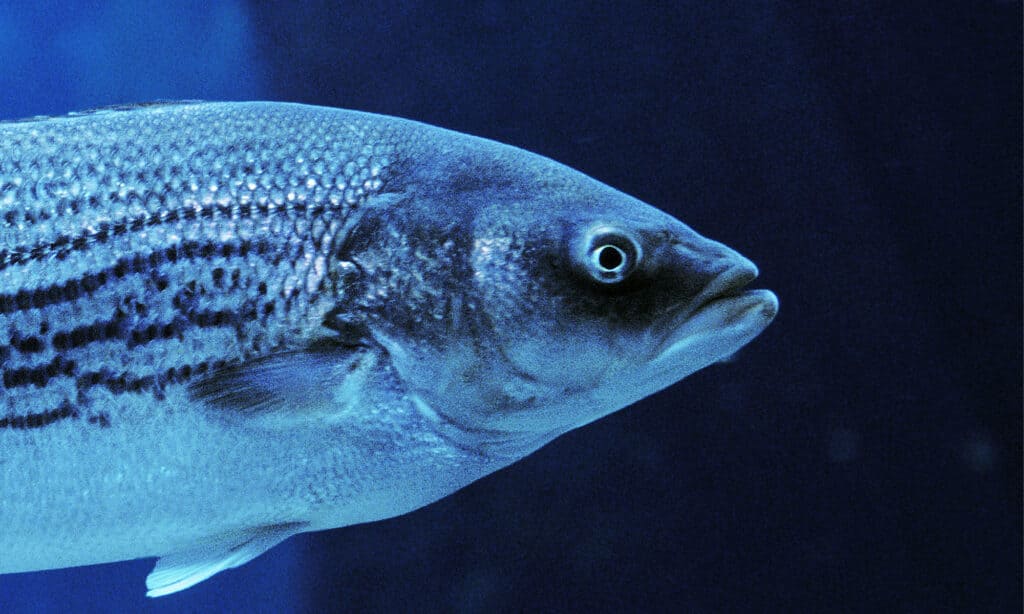
Striped bass is a species of anadromous fish native to the Atlantic and Gulf Coast regions of the United States.
©iStock.com/slowmotiongli
Renowned as both a prized game fish and a vital contributor to the marine ecosystem, striped bass, including hybrid variations, are actively stocked in Indiana’s picturesque Lake Monroe. Each year, the Department of Natural Resources introduces fingerlings of both species, nurturing their growth until they attain a catchable size of approximately 14 inches in a span of 2 to 3 years. For anglers seeking the thrill of the striped bass, the prime time to cast their lines in the depths of Lake Monroe is during the bountiful seasons of spring through fall. While these remarkable fish can be found inhabiting a wide range of habitats, they are most frequently encountered in the main lake, meandering alongside the mouths of rivers and streams, and lingering in the inviting shallows.
16. White Crappie (Pomoxis annularis)
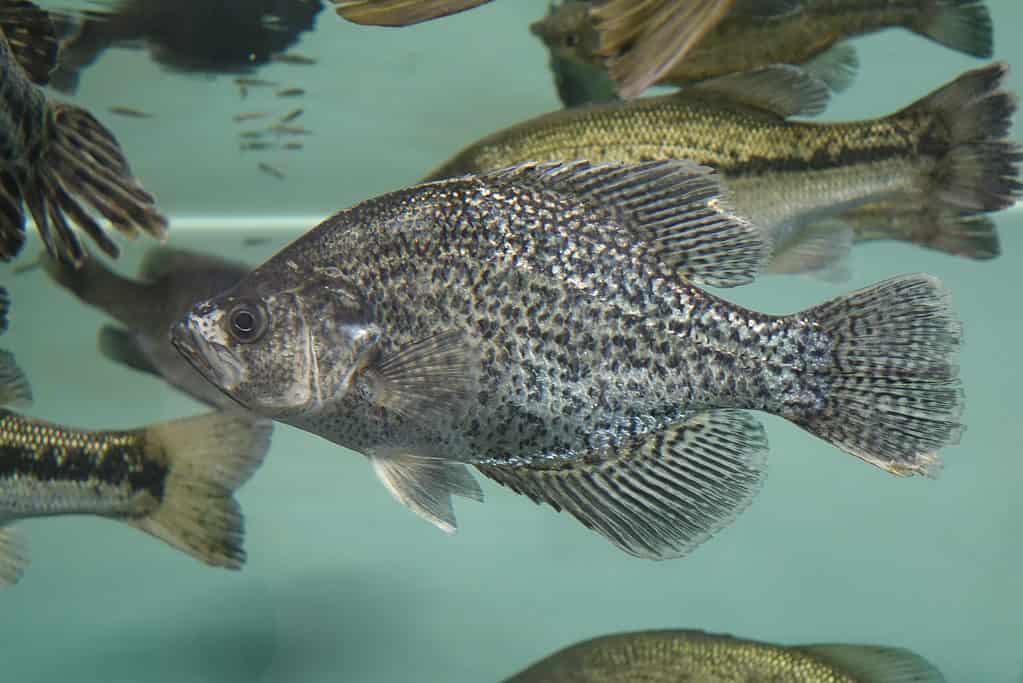
Keep an eye out for the white crappie as they exhibit a captivating behavior of schooling, often forming impressive congregations that are amazing to watch.
©Wirestock Creators/Shutterstock.com
The white crappie is a fascinating freshwater fish native to North America. These beauties thrive in a variety of aquatic habitats such as lakes, rivers, and ponds, particularly favoring clear, shallow waters brimming with lush vegetation. If you’re in Indiana, you’ll find white crappie scattered across the state’s majestic lakes and rivers, with a higher concentration up north where the colder, crystal-clear waters create a perfect haven for them. As spring arrives and water temperatures reach around 50 degrees Fahrenheit, white crappie engage in their annual ritual of spawning. With modest growth patterns, these remarkable creatures typically measure around 10 to 12 inches in length, accentuated by their alluringly shaded fins.
17. Yellow Perch (Perca flavescens)
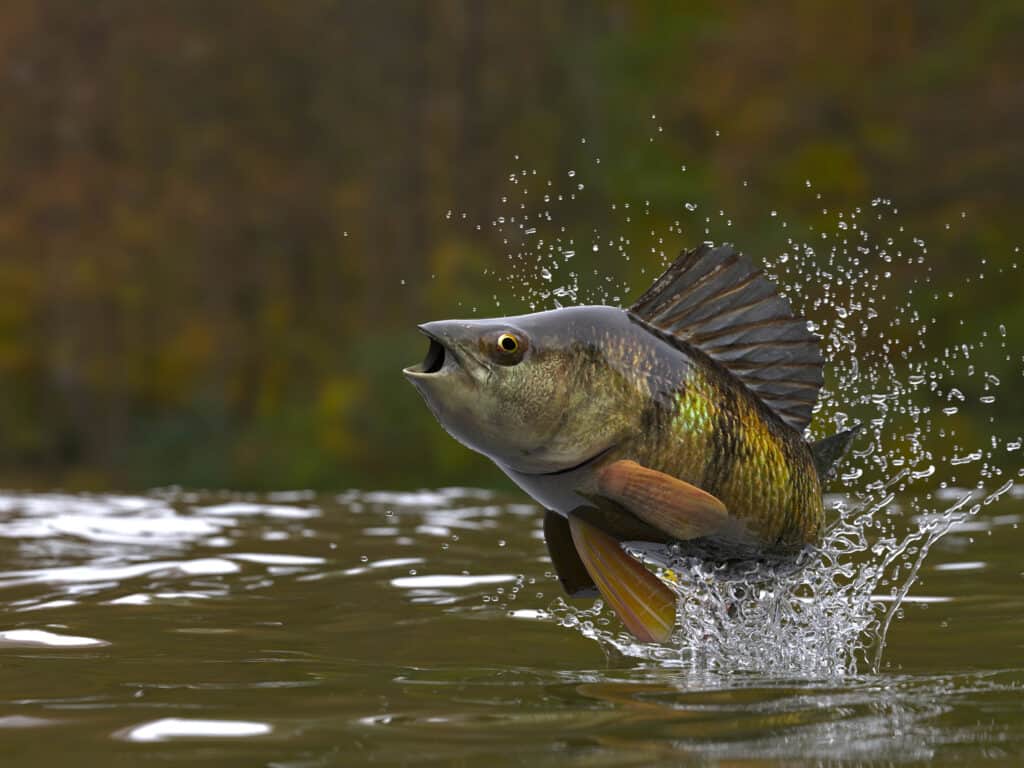
Sometimes yellow perch jumps out of the water to snare insects.
©bekirevren/Shutterstock.com
Yellow perch are an incredibly sought-after panfish native to Indiana. Fishing for yellow perch in Indiana holds a significant place in the cultural heritage, although the perch fishery has faced its share of challenges due to invasive species, resulting in changes to the ecosystem. These vibrant fish thrive in various habitats like lakes, rivers, and reservoirs across Indiana, with a particular fondness for clear waters adorned with lush aquatic vegetation. Get ready for exciting adventures during the prime seasons of spring and fall when the water temperature ranges from 50 to 70 degrees Fahrenheit. With their schooling nature, the key to success lies in targeting areas bustling with abundant baitfish. Happy fishing, my fellow enthusiasts!
Summary of 17 Amazing Fish Living in Lake Monroe
| # | Common Name | Scientific Name | Size |
|---|---|---|---|
| 1. | Black crappie | Pomoxis nigromaculatus | 10 to 12 inches |
| 2. | Bluegill | Lepomis macrochirus | 6 to 8 inches |
| 3. | Brown bullhead | Ictalurus nebulosus | 12 to 18 inches |
| 4. | Channel catfish | Ictalurus punctatus | 18 to 24 inches |
| 5. | Common carp | Cyprinus carpio | 18 to 24 inches |
| 6. | Flathead catfish | Pylodictis olivaris | 36 to 48 inches |
| 7. | Gizzard shad | Dorosoma cepedianum | 6 to 8 inches |
| 8. | Hybrid striped bass | Morone saxatilis x Morone chrysops | 18 to 24 inches |
| 9. | Largemouth bass | Micropterus salmoides | 12 to 18 inches |
| 10. | Northern pike | Esox lucius | 24 to 36 inches |
| 11. | Pumpkinseed | Lepomis gibbosus | 4 to 6 inches |
| 12. | Rainbow trout | Oncorhynchus mykiss | 12 to 18 inches |
| 13. | Rock bass | Ambloplites rupestris | 6 to 8 inches |
| 14. | Smallmouth bass | Micropterus dolomieu | 12 to 18 inches |
| 15. | Striped bass | Morone saxatilis | 24 to 36 inches |
| 16. | White crappie | Pomoxis annularis | 10 to 12 inches |
| 17. | Yellow perch | Perca flavescens | 6 to 8 inches |
The photo featured at the top of this post is © Shannon VanB Photography/Shutterstock.com
Thank you for reading! Have some feedback for us? Contact the AZ Animals editorial team.







